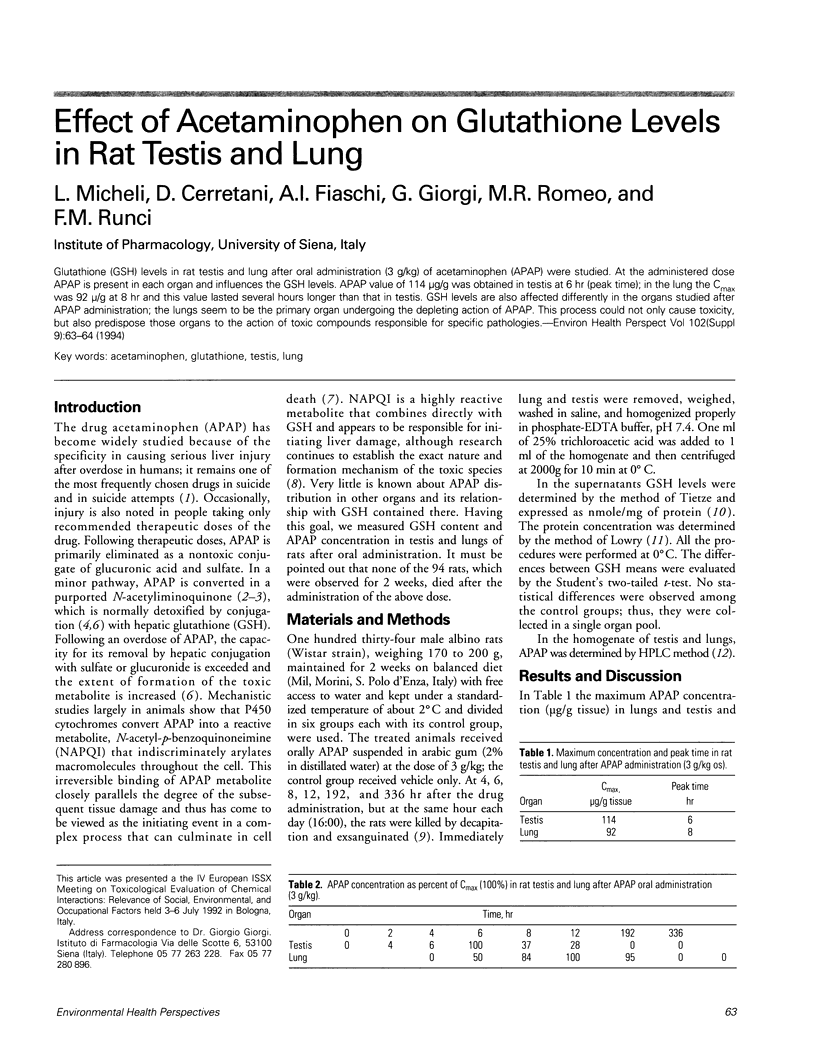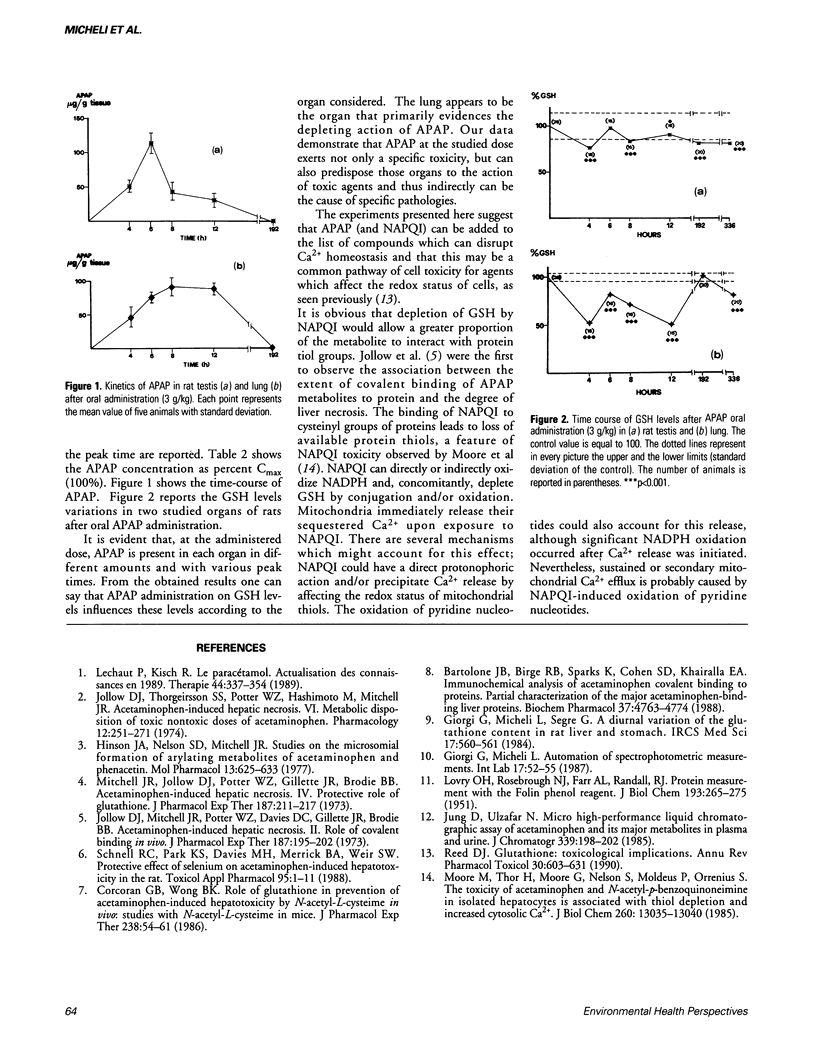Abstract
Glutathione (GSH) levels in rat testis and lung after oral administration (3 g/kg) of acetaminophen (APAP) were studied. At the administered dose APAP is present in each organ and influences the GSH levels. APAP value of 114 micrograms/g was obtained in testis at 6 hr (peak time); in the lung the Cmax was 92 mu/g at 8 hr and this value lasted several hours longer than that in testis. GSH levels are also affected differently in the organs studied after APAP administration; the lungs seem to be the primary organ undergoing the depleting action of APAP. This process could not only cause toxicity, but also predispose those organs to the action of toxic compounds responsible for specific pathologies.
Full text
PDF

Selected References
These references are in PubMed. This may not be the complete list of references from this article.
- Bartolone J. B., Birge R. B., Sparks K., Cohen S. D., Khairallah E. A. Immunochemical analysis of acetaminophen covalent binding to proteins. Partial characterization of the major acetaminophen-binding liver proteins. Biochem Pharmacol. 1988 Dec 15;37(24):4763–4774. doi: 10.1016/0006-2952(88)90350-4. [DOI] [PubMed] [Google Scholar]
- Corcoran G. B., Wong B. K. Role of glutathione in prevention of acetaminophen-induced hepatotoxicity by N-acetyl-L-cysteine in vivo: studies with N-acetyl-D-cysteine in mice. J Pharmacol Exp Ther. 1986 Jul;238(1):54–61. [PubMed] [Google Scholar]
- Hinson J. A., Nelson S. D., Mitchell J. R. Studies on the microsomal formation of arylating metabolites of acetaminophen and phenacetin. Mol Pharmacol. 1977 Jul;13(4):625–633. [PubMed] [Google Scholar]
- Jollow D. J., Mitchell J. R., Potter W. Z., Davis D. C., Gillette J. R., Brodie B. B. Acetaminophen-induced hepatic necrosis. II. Role of covalent binding in vivo. J Pharmacol Exp Ther. 1973 Oct;187(1):195–202. [PubMed] [Google Scholar]
- Jollow D. J., Thorgeirsson S. S., Potter W. Z., Hashimoto M., Mitchell J. R. Acetaminophen-induced hepatic necrosis. VI. Metabolic disposition of toxic and nontoxic doses of acetaminophen. Pharmacology. 1974;12(4-5):251–271. doi: 10.1159/000136547. [DOI] [PubMed] [Google Scholar]
- Jung D., Zafar N. U. Micro high-performance liquid chromatographic assay of acetaminophen and its major metabolites in plasma and urine. J Chromatogr. 1985 Apr 12;339(1):198–202. doi: 10.1016/s0378-4347(00)84644-7. [DOI] [PubMed] [Google Scholar]
- LOWRY O. H., ROSEBROUGH N. J., FARR A. L., RANDALL R. J. Protein measurement with the Folin phenol reagent. J Biol Chem. 1951 Nov;193(1):265–275. [PubMed] [Google Scholar]
- Lechat P., Kisch R. Le paracétamol. Actualisation des connaissances en 1989. Therapie. 1989 Sep-Oct;44(5):337–354. [PubMed] [Google Scholar]
- Mitchell J. R., Jollow D. J., Potter W. Z., Gillette J. R., Brodie B. B. Acetaminophen-induced hepatic necrosis. IV. Protective role of glutathione. J Pharmacol Exp Ther. 1973 Oct;187(1):211–217. [PubMed] [Google Scholar]
- Moore M., Thor H., Moore G., Nelson S., Moldéus P., Orrenius S. The toxicity of acetaminophen and N-acetyl-p-benzoquinone imine in isolated hepatocytes is associated with thiol depletion and increased cytosolic Ca2+. J Biol Chem. 1985 Oct 25;260(24):13035–13040. [PubMed] [Google Scholar]
- Reed D. J. Glutathione: toxicological implications. Annu Rev Pharmacol Toxicol. 1990;30:603–631. doi: 10.1146/annurev.pa.30.040190.003131. [DOI] [PubMed] [Google Scholar]
- Schnell R. C., Park K. S., Davies M. H., Merrick B. A., Weir S. W. Protective effects of selenium on acetaminophen-induced hepatotoxicity in the rat. Toxicol Appl Pharmacol. 1988 Aug;95(1):1–11. doi: 10.1016/s0041-008x(88)80002-4. [DOI] [PubMed] [Google Scholar]


